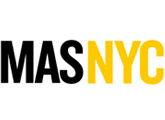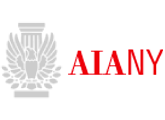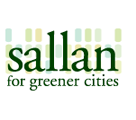
Point A:
Charting the High Performance Building Movement

New York City High Performance Building Series Event One of Four
Event One | Event Two | Event Three | Event Four
NYC HPB Report (1) | More Than Green
Anticipating the release of a new City policy being developed by the Mayor's Sustainability Task Force, the Municipal Art Society (MAS) hosted a forum with Kate Ascher, Executive Vice President for Infrastructure, and Ariella Rosenberg, Senior Project Manager, of the Economic Development Corporation (EDC) to discuss the policy implications of the New York City Energy Policy Task Force Report (Report), a 28-point recommendation plan that outlines how to meet the future energy needs of New York City through energy supply, infrastructure, energy efficiency, and sustainable development. The June 8th forum was the first in a series of panels that will address high performance buildings.
Sponsored by MAS, the Sallan Foundation, and the New York City Chapter of the American Institute of Architects Committee on the Environment, this session initiated an important interdisciplinary discussion among community leaders, policy makers, developers, architects, local business owners and environmental activists to share knowledge about recent developments and innovative ideas for a greener city.
At the center of the discussion is the recent trend of high performance buildings and their contribution in meeting the Report's target of developing 2,600 megawatts (MW) of new electric resources by 2008, including a goal of 675 MW from demand reduction. The stated goals of the Report are to ensure reliability of the power supply, secure the economic growth of business and industry and to protect the built and natural environments of New York City. Said Rosenberg, "The goals of the Task Force illustrate a shift in viewing energy only from the supply side to a more comprehensive approach that includes conservation and greater efficiency."
While focusing on high performance buildings, the forum quickly developed into a broad discussion on the recommendations of the Report's sustainability implications. The Report outlined a diversified approach of increasing distributed resources such as peak load management schemes, energy efficiency and on-site generation, increasing overall supply, long-term infrastructure planning and the continuance of New York City as the leader of innovative sustainable practices as the means to reach its goals. Said Rosenberg, "There is no silver bullet. You can't just build more power plants or just put solar panels on every roof. We must have a diversified approach towards securing our future power needs." Added Ascher, "The EDC is working with the city across the board on initiatives to secure a sustainable future."
Rosenberg is currently working to develop and produce more sustainable practices amongst city agencies including the EDC. She has been directly involved with EDC initiatives like the creation of New York City specific supplements to LEED (Leadership in Energy And Environmental Design) standards and the use of renewable wind energy at the EDC's Brooklyn Army and Bush business terminals. Rosenberg also chairs both the Energy Working Group of the Mayor's Sustainability Task Force and the Inter-Agency Working Group of the Energy Policy Task Force.
At the conclusion of the forum, there was a question and answer session where Rosenberg and Ascher, as well as Gil Quiniones, Senior Vice President of Energy and Telecommunications at the EDC, and Robert Kulikowski, Director of the Office of Environmental Management, answered questions from the audience.
Q: Will the Mayor's Sustainability Task Force develop a citizens advisory board before the release of its report?
A: Right now, in the current phase, the Mayor's Task Force on Sustainability is geared toward encouraging sustainable practices within municipal government. However, the practices of the government will diffuse to the entire city. We want to eventually broaden our scope to the entire city, but right now we are just concentrating on what we can most effectively impact, and that is the many governmental agencies. In contrast, the Energy Policy Task Force is a public-private initiative with representatives from the business and real estate sectors, city and state agencies, utilities, and environmental and community groups.
Q: Energy pricing in this city does not reflect the actual costs of its production, especially during peak load periods. Does the Task Force recommend any real time pricing mechanism so that customers know when they are placing excessive stress on the power supply?
A: Big customers are on a block pricing system. We do recognize the need to use real time, and we are currently piloting a few projects in high density residential buildings. However, it would be difficult to have a blanket approach to real time pricing because most buildings do not have the infrastructure, the technology, and/or the money to implement this type of strategy. The Task Force is in implementation mode and this means we are conducting a lot of planning around this issue.
Q: Many coastal cities are using wind turbines off the coast for generation. Although there are some transmission difficulties with this approach, is New York City considering such a strategy?
A: The City supports the use of green power. The use of green power helps to protect the environment since it produces none of the emissions associated with global warming, acid rain, and particulate matter. Purchasing green power also supports energy diversity and independence from fossil fuels. That kind of independence diversifies risk of various kinds, including financial and fuel risks. Finally, purchasing green power may help develop new energy capacity.
New York City plans to purchase 20 MW of wind power from upstate New York beginning 2008. It already purchases over three percent of its electricity demand from small hydro plants. It also has 2.2 MW of fuel cells and over 300 kilowatts (KW) of photovoltaic. In addition, the City has been exploring other potential renewable energy investments within New York City's borders, including a trial wind turbine near the East River. The City plans to continue to purchase green power and increase its renewable energy portfolio.
Q: How are we to encourage energy efficiency education?
A: EDC has facilitated the inclusion of over 200 NYC teachers into training for the Energy Smart Student Program, a statewide energy efficiency education program for K-12 classroom teachers sponsored by the New York State Energy Research and Development Authority (NYSERDA) and the New York Energy Smart Program. This program specializes in training teachers to teach school children energy science and energy conservation lessons, including exciting hands-on activities.
Q: Many dry cleaners are effectively utilizing their excess heat to produce power. How will co-generation play into the Task Force's recommendations?
A: Co-generation is a great way to increase efficiency. Of the 28 recommendations outlined in the Task Force report, a significant amount of these address or mention co-generation.
Q: Con Edison is in the business of power production. Will Con Edison be interested in on-site generation, or any efficiency initiative for that matter?
A: Con Edison is in a paradox. You can see how Con Edison would be reluctant to promote programs that result in reduced revenue for the utility. However, on-site generation could reduce the burden on the grid, and with energy efficiency investments, it could lead to increased reliability and potentially reduced long-term infrastructure investment. We understand that it is a long process to shift the current mindset.
Q: How is Con Edison going to be forced to participate in the goal of reaching 675 MW of distributed power in the next three years?
A: In each energy rate case, we have the opportunity to negotiate with power companies in order to achieve our efficiency goals. As part of the Con Edison Electric Rate case, approved by the Public Service Commission (PSC) in March 2005, Con Edison ratepayers were authorized to contribute $224 million toward distributed power sources. This includes 150 MW in targeted constrained areas. The PSC is a state entity that has authority over expenditures of New York utility companies.
Q: Why is the Task Force concentrating so much on LEED designation and not Energy Star?
A: First of all, there is already a local law that requires Energy Star appliances in all city buildings. This presentation concentrated on LEED certification because this forum is about high performance buildings. Also, LEED is the most nationally-recognized and universal indicator of energy efficiency and sustainability. New York City is inherently energy efficient, and using LEED enables us to showcase this sustainability to the entire nation. In a report released this past week on World Environmental Day, New York City was ranked the most energy efficient city with a population of more than 1 million people in the United States.
Q: What about a law that requires LEED certification in all new buildings?
A: Two cities in the US currently require a LEED rating for private new construction. We are watching their progress and, as part of the Mayor's Task Force on Sustainability, and we continue to research and plan the best ways to move New York City towards more sustainable development.
Q: There are three major redevelopment plans occurring in New York City- the Hudson Yards, Greenpoint/Williamsburgh and Lower Manhattan. Has New York City required any standard of energy efficiency for these projects?
A: While different developments are happening, the Mayor's Task Force on Sustainability is planning policies that will be consistent throughout the city, including these three project sites.
Q: With a goal of 2,600 megawatts, a portion of this must be new generation. When new plants are constructed, how can we ensure environmental justice?
A: The City and other Energy Policy Task Force members strongly support reenactment of Article X. Article X of the New York State Public Service Laws sets forth a review process in New York State for consideration of any application to construct and operate an electric generation facility with a capacity of 80 MW or more. The review process includes environmental and community impacts. In addition, the Task Force has also recommended the repowering of existing power plants to avoid the monetary and social costs of buildings new plants.
Q: Is there anyone working on a cost-benefit analysis for environmentalism?
A: We are lucky in New York City to have so many non-profits like WasteMatch, the New York Industrial Retention Network (NYIRN), and NYC Apollo working on cost benefit studies regarding deconstruction, energy efficiency, and high performance buildings. Many of these studies concentrate on job creation through sustainable practices. It is important to realize that there are hardcore monetary benefits in implementing environmentally conscious policies.
For more information on the Mayor's Energy Policy Task Force or the EDC please visit the EDC website at www.nycedc.org.






